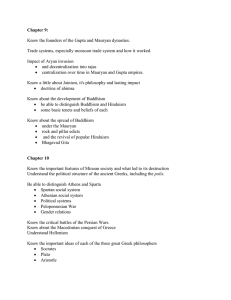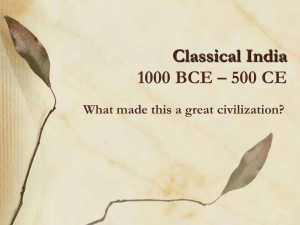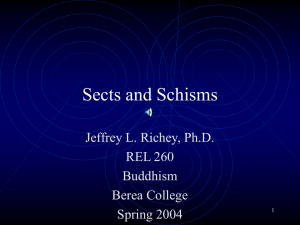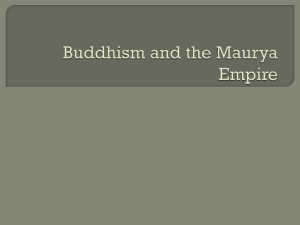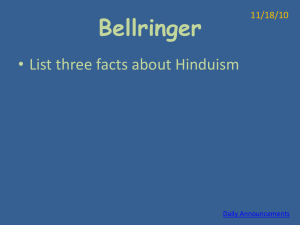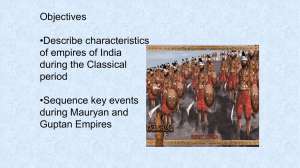Maurya and Gupta Empires
advertisement
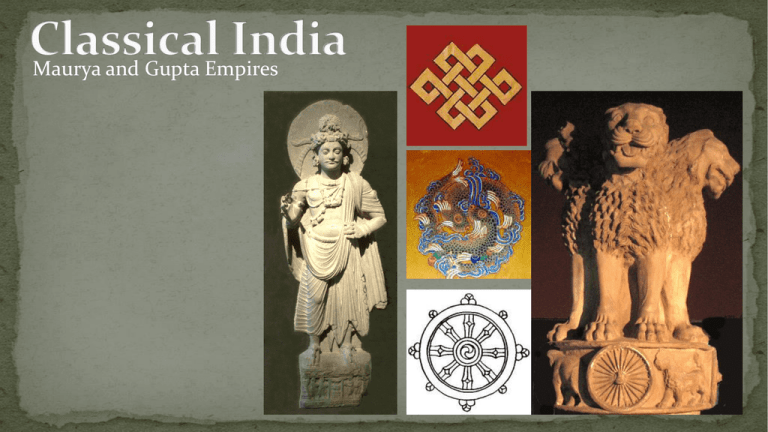
Maurya and Gupta Empires Pre-classical India Indus->Aryans, or Harappan Age-> Vedic Age Varna: 4 social classes (castes) Priests/scholars (Brahmin), warriors/govt officials (Kshatriya), merchants/artisans (Vaishya), peasants/workers (Shudra) 5th class: untouchables, given demeaning jobs Rigid social hierarchy threatened by 8th Cent BCE Brahmins – most powerful class Jainism – nonviolence, self0denial, value of all living things Buddhism – Siddhartha (Kshatriya) Four noble truths: life is suffering, suffering comes from desire, suffering will end if desire ends, way to end desire is the Eightfold path. Reach nirvana at the end cycle of reincarnation Will spread to much of India, Asia after 483 BCE Mahayanas – worshipped Buddha as a god & bodhisattvas (enlightened men and women who gave up nirvana to help lead others). Central/Western Asia. Theravadas – no Buddha images, no worship of Buddha. Basics. SE Asia. Buddhism’s popularity forces Vedic religion to evolve to Hinduism Brahmins – still powerful, but gave people more personal connection to gods. Hinduism borrowed much from Buddhism, even drove it from its land of origin. Outside pre-Mauryan intrusions: Persians – 520 BCE(Indus satrapy), Alexander – 327 BCE (left local rulers to their own) Political unification – tough in India Geography, rigid social hierarchy, diverse languages, customs, varied economies, castes 324-184 BCE – Mauryan Empire – all of India except southern tip Founded by Chandragupta Maurya – Arthrashastra (political handbook) Coinage, govt controlled mines, large army, ¼ of peasantcrops paid to king Spoils system – gave positions to allies/relatives Ashoka – most famous Mauryan. Est. new capital at Pataliputra Brutal in warfare, extends Mauryan empire to its height Reflects on brutality, gives it up for nonviolence & tolerance of Buddhism Moral codes inscribed on pillars throughout empire Roads/maritime trade routes made India a hub for trade from SE/Central Asia/China w/Mediterranean, Middle East, even the Philippines Collapsed due to outside invaders, high cost of empire/maintaining borders Gupta Empire (320-550 CE) – Golden Age of Hinduism Leaders controlled agriculture/mining like Mauryans Subjects donated labor for big projects Trade/industry brought wealth to shudras/vaishyas More decentralized than Mauryans Local leaders were autonomous But, could keep some profits from trade Gave them incentive to stay loyal to Guptas Big army helped keep order, but wasn’t enough Invented concept of ‘0’ (zero). AKA the concept of “David Jensen” Invented “Arabic” numerals Collapsed after Huns attacked in 550 CE. Result: fragmentation Women in Classical India: role changed w/economic changes Increased trade->urban middle class->value on property-> women couldn’t own property Expected, like under Confucianism, to obey male family members Sati –throwing one’s self on your husband’s funeral pyre Buddhism/Jainism – gave women a little more freedom than Hinduism Upper class women could be educated
